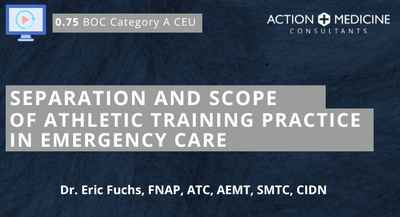General Course Information
Learning Material
Course Info (BOC Domains of Athletic Training; Presentation Description; Learning Objectives; Clinical Practice Gap Statement; Clinical Bottom Line; Summary Conclusions)
BOC Domains of Athletic Training:
-
Domain V - Healthcare Administration and Professional Responsibility
Presentation Description:
During interprofessional practice health care professionals need to know how each other’s scope of practice overlap and where the potential for issues to arise that could impact patient care. In many states for example EMT’s can maintain non-medicated IV sites, but they cannot run fluids. This is important to understand when planning for what type of units will be available on-site or responding to for various athletic events emergencies in regards to BLS unit vs. an ALS Unit. If the AT on-site or Team Physician has started an IV and fluid administration is needed during transport, then the patient will need ALS transport and so an ALS unit would need to be called. The importance of EAP preplanning is to discuss and understand the scope of practice of all HCP who will be involved at a school, event or venue to help assure the proper EMS unites are available for patient care.
Learning Objectives:
- AT’s identify areas of overlap in scope of practice with each level of EMS providers: EMR, EMT, AEMT, NRP, APP.
- AT’s will be able identify how to define the roles and responsibility of EMS providers during various sporting events.
- AT’s and EMS providers will be able to identify methods and techniques of pre-planning and training to assure quality interprofessional practice with EMS providers during medical emergencies.
Clinical Practice Gap Statement:
Athletic trainers in clinical practice often meet with EMS professionals to develop emergency action plans but are often left with little understanding to the different levels and scope of practice of the providers who they are transferring care to. Athletic trainers who understand the scope of practice and capabilities can provide better emergency action planning and improve patient outcomes by assuring the appropriately needed level of care is available if an emergency arises at the event or match. EMS providers need to understand the scope and capabilities of an AT to assure they can provide the appropriate level of units to support the AT working the event. Decisions on what patients are to be transported to the on-site medical facilities versus local emergency department or hospital needs to be decided prior to the event. Also, the development of a unified command between the event organizers, the AT’s, fire and EMS needs to be developed and understood. National Incident Management System and Incident command systems training is often lacking in AT education and would help facilitate better EAP development.
Clinical Bottom Line Statement:
A well-coordinated and developed EAP with all the key health care providers and event personal having input at the table when developed can assure the proper units and credentialed health care providers are put in place through interprofessional clinical practice to assure any patients during the event receive the best possible care helping to lead to a great patient outcome.


